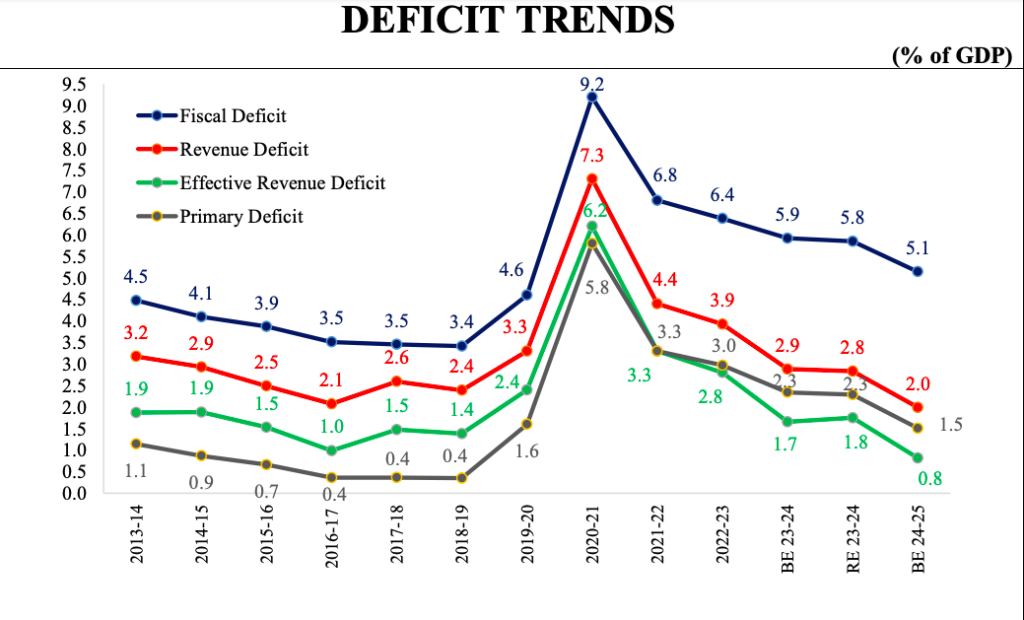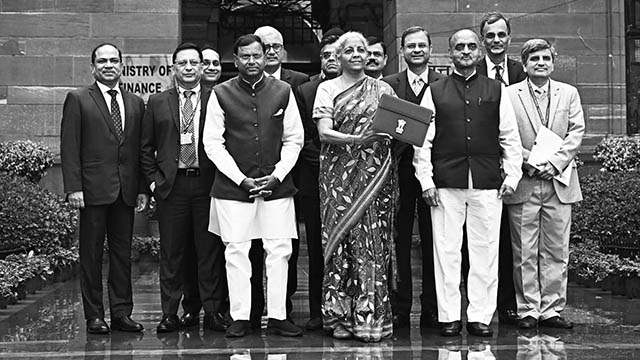India's pre-election Interim Budget 2024-25 raises eyebrows with its lack of populist measures and focus on retaining a status quo in the economy.
India’s Interim Budget 2024-25, presented by Finance Minister Nirmala Sitharaman, landed with a thud instead of the bang many expected in an election year. Where were the populist measures, the tax cuts, and the grand infrastructure promises? Instead, we get a budget characterised by cautious conservatism, seemingly unfazed by the crucial 2024 Lok Sabha elections looming on the horizon.
Mrs Sitharaman showed a brazen apathy to the cause of millions of voters who’d decide the fate of the incumbent Bharatiya Janata Party (BJP) that has been ruling India federally and most of its crucial states for a decade now.
But is this conservatism a calculated risk or a misplaced gamble by Prime Minister Narendra Modi? Let’s delve deeper.
Numbers tell a story, but what story?
The total budget expenditure (BE) of the Union government in the financial year (FY) 2024-25 has been estimated at Rs 47.66trn, which is Rs 2.75trn more than the revised estimate (RE) of FY 2023-24—Rs 44.90trn. Out of the total expenditure, Rs 11.11trn has been earmarked for capital expenditure (capex). It’s 16.9% more than the capex of the RE of FY 2023-24.
Mr Modi’s government has been boasting of a major economic revival through infrastructure building, for which it had allocated Rs 10trn (BE) in FY-2023-24 and spent Rs 9.5trn. Yet, when juxtaposed with unemployment data discrepancies between government and private sectors, where a difference of 4 to 5 percentage points exists, questions arise: who truly benefits from this massive capex spending?
Economists warn of stagnant job growth, while the government touts a growing start-up ecosystem as a sign of progress. This narrative seems to conveniently ignore the elephant in the room: millions of Indians seeking meaningful employment.
Mrs Sitharaman, known for her aversion to mentioning “unemployment” in budget speeches, presents a budget devoid of major stimulus measures. Instead, a slight increase for crucial rural employment schemes like NREGA to Rs 860bn as the RE for FY 2023-24 is estimated to be the same amount, and marginal adjustments (BE) for minorities and Scheduled Castes seem like calculated moves to address potential flashpoints without breaking the bank.
Here are some examples of Mrs Sitharaman’s manoeuvres:
| Schemes | BE (FY 2023-24) | RE (FY 2023-24) | BE (FY 2024-25) |
| NREGA | Rs 600bn | Rs 860bn | Rs 860bn |
| Minority development | Rs 6.1bn | Rs 5.5bn | Rs 9.13bn |
| ST development | Rs 42.95bn | Rs 32.86bn | Rs 42.41bn |
| SC development | Rs94.09bn | Rs 67.80bn | Rs 95.60bn |
| Pradhan Mantri Awas Yojna (housing for rural poor) | Rs 795.90bn | Rs 541.03bn | Rs 806.71bn |
| National Rural Drinking Water Mission | Rs 700bn | Rs 700bn | Rs 701.63bn |
| Rural Road Development Programme (PMGSY) | Rs 190bn | Rs 170bn | Rs 190bn |
| Ayushman Bharat- Pradhan Mantri Jan Arogya Yojana (PMJAY/national health insurance) | Rs 72bn | Rs 68.81bn | Rs 75bn |
| Pradhan Mantri Ayushman Bharat Health Infrastructure Mission (PMABHIM) | Rs 42bn | Rs 21bn | Rs 41.08bn |
| Urea subsidy (major fertiliser) | Rs 1.31trn | Rs 1.28trn | Rs 1.19trn |
| Prime Minister Employment Generation Programme (PMEGP) | Rs 27bn | Rs 29.58bn | Rs 23bn |
Now the above figures show how the low RE provides an opportunity for the government to either retain the previous BE or increase it, realising that there will be a major lacuna in implementing the projects under such schemes.
Also, consider a vital sector like education, which faces a curious dichotomy. Mr Modi’s government has increased the total allocation for school education in the Interim Budget 2024-25. While in FY 2023-24, the RE of school education is estimated at Rs 724.74bn, the BE for FY 2024-25 has been raised to Rs 730bn.
However, for higher education, it has been the contrary. While Rs 572.44bn is the estimated RE for FY 2023-24, the BE has been reduced to Rs 476.19bn for FY 2024-25. This indicates that the government is going to show indifference towards higher education—evident from the 60% cut in the allocations for the University Grants Commission—when it’s pushing for the implementation of the contentious National Education Policy of 2020.
So, what’s driving this seemingly nonchalant approach to popular demands?
Interim Budget 2024-25: What’s behind the Modi government’s audacity?
What made the Modi government so confident that Mrs Sitharaman could dare to bring a pale budget in an election year?
Is it an attempt to reduce the fiscal deficit?
No, it’s not.
Mr Modi’s government is running the world’s largest universal food supply programme catering to over 800m people who are unable to buy food grains. It has allocated Rs 2trn for the project.
Moreover, the fiscal deficit has been showing no sign of reversal to the pre-2019 situation. The fiscal deficit, which was 3.4% of the GDP in FY 2018-19, has been constantly on the rise since FY 2019-20, reached a peak during the pandemic and has shown no signs of easing. Here is the chart of the fiscal deficit in the last ten years.

So, what is it that makes Mr Modi’s government unapologetically nonchalant towards popular demands like employment generation, subsidy in agriculture, tax sops for the salaried middle class and providing subsidies to the poor?
It’s Mr Modi’s hubris, driven by the magnificent success achieved by his Hindutva theatrics, especially during the recent consecration of the Ram temple built on the site of the demolished 15th-century Babri Masjid in Ayodhya. Mr Modi and his cohorts have played the trump card of Hindutva, which the BJP expects will gift it a hattrick landslide victory in the forthcoming Lok Sabha elections.
Will Mr Modi’s risky endeavour pay rich dividends?
Mr Modi is confident of a smooth sail in the Lok Sabha elections after seeing the mass hysteria created over the Ram Mandir inauguration and the victory of the BJP in the three states out of five that went to polls in 2023. So far, except for Himachal Pradesh and Karnataka, the BJP has not faced defeat in any major state-level elections in the last few years.
But is this a gamble too far? While recent state election wins favour the BJP, economic distress remains a potent force. Will divisive politics drown out concerns about jobs, rising costs, and a widening inequality gap?
Only time will tell if Mr Modi’s gamble pays off, or if the Indian electorate prioritises economic concerns over religious rhetoric.
Unsigned articles of People's Review are fruit of the collective wisdom of their writers and the editors; these articles provide ultimate insight into politics, economy, society and world affairs. The editorial freedom enjoyed by the unsigned articles are unmatchable. For any assistance, send an email to write2us@peoplesreview.in

